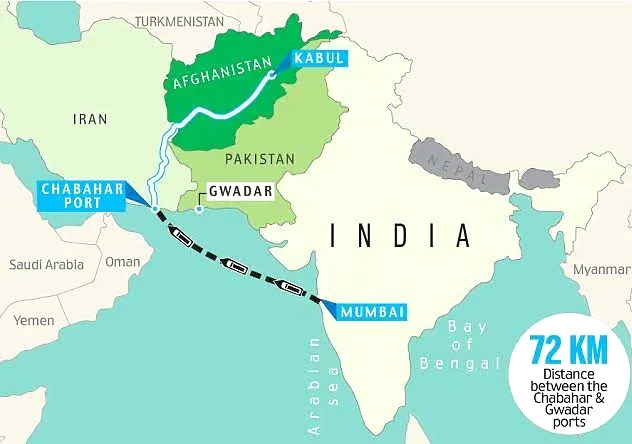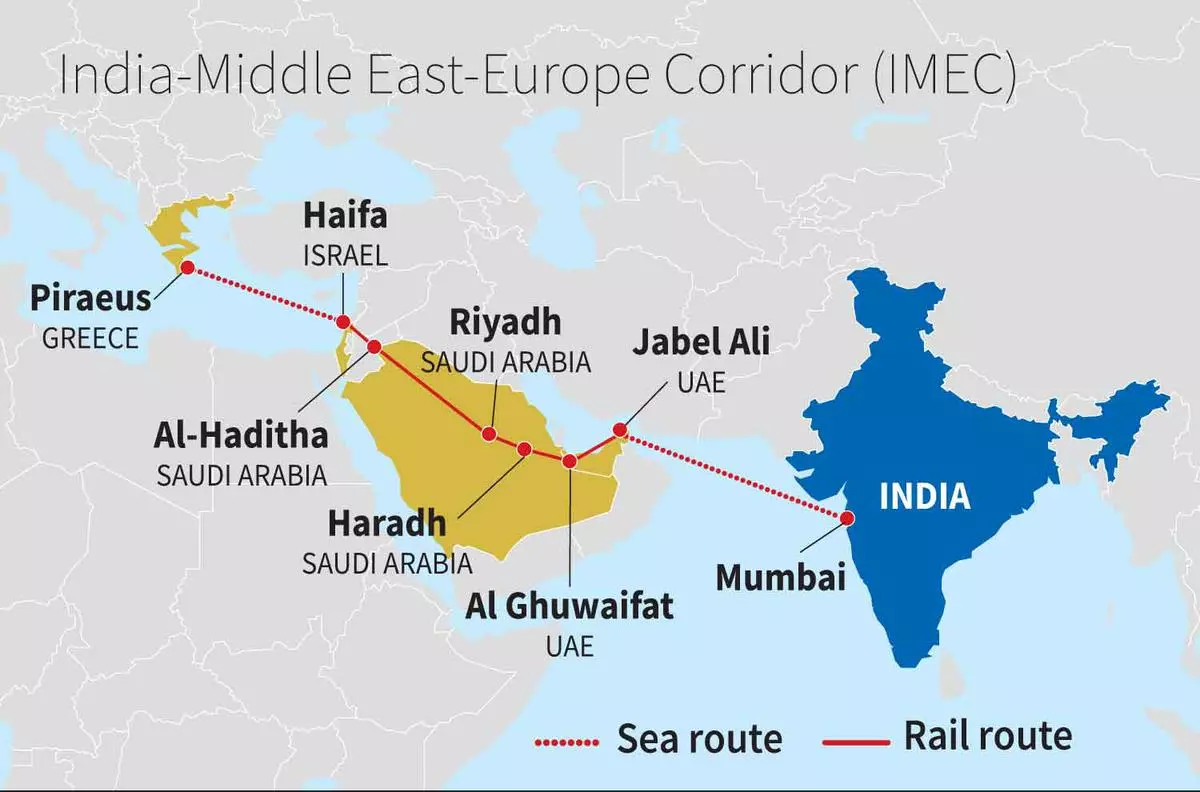International Relations
Chabahar Port Agreement
- 17 May 2024
- 10 min read
For Prelims: Chabahar port, International North-South Transport Corridor, Belt and Road Initiative
For Mains: Significance of Chabahar Port for India, Areas of Contention Between India and Iran.
Why in News?
Recently, India and Iran signed a 10-year contract for operating the Chabahar port in Iran.
- This long-term agreement was signed between Indian Ports Global Ltd. (IPGL) and Port and Maritime Organisation (PMO) of Iran, enabling operation of the Shahid-Beheshti terminal.
- Signing of a long-term contract with Iran is part of India’s strategic and economic vision for Central Asia and beyond.
Why is Chabahar Port Important for India?
- About:
- Chahabar is Iran's oceanic port nearest to India. It is situated in Sistan and Baluchistan Province, on the Makran coast. It lies in the Gulf of Oman.
- Chahabar Port project has two main ports called the Shahid Kalantari Port and the Shahid Beheshti Port.
- Iran had offered India the project of developing the Shahid Beheshti port which was well received by India.
- Progress and Updates Regarding the Chabahar Port Deal:
- India signed a memorandum of understanding (MoU) for the development of the Chabahar port in May 2015.
- In May 2016, India, Iran, and Afghanistan signed a trilateral agreement to establish the International Transport and Transit Corridor, also known as the Chabahar Agreement.
- This agreement aimed to improve transportation and trade connectivity between the three countries by utilising the port of Chabahar in Iran as a key transit point.
- However, the finalisation of the long-term agreement has been delayed by several factors including differences on some clauses in the pact.
- The point of disagreement was the location of arbitration for disputes. India preferred a neutral country, while Iran insisted on its own courts or a favourable one.
- Now, both parties have agreed on a compromise that satisfies their respective interests. The contract stipulates that any disagreements should be settled through open communication and cooperation between the leaders of both countries.
- This fresh long-term agreement aims to supersede the initial contract, spanning a duration of 10 years with automatic renewal provisions.
- Significance of Chabahar Port:
- Alternative Trade Route: Historically, India's access to Afghanistan and Central Asia has been largely dependent on transit routes through Pakistan.
- Chabahar Port offers an alternative route that bypasses Pakistan, reducing India's reliance on its neighbour for trade with Afghanistan and beyond.
- Also, Chabahar port will boost India's access to Iran, the key gateway to the International North-South Transport Corridor(INSTC) that has sea, rail and road routes between India, Iran, Russia, Central Asia and Europe.
- Economic Benefits: Chabahar will play a crucial role in India's efforts to enhance connections with the resource-rich Central Asian countries and Afghanistan.
- It will allow India to diversify its trading routes and gain enhanced access to the markets of Russia, Eurasia and Europe, apart from Iran and Afghanistan.
- Cargo movement through INSTC route is expected to save 30% in cost and 40% in transportation time, ensuring quick turnaround at a competitive cost.
- Central Asian nations, rich in resources but without direct access to the sea like Kazakhstan and Uzbekistan, have shown interest in utilising Chabahar to connect to the Indian Ocean Region and tap into the Indian market.
- It will allow India to diversify its trading routes and gain enhanced access to the markets of Russia, Eurasia and Europe, apart from Iran and Afghanistan.
- Humanitarian Assistance: Chabahar Port can serve as a crucial entry point for humanitarian assistance and reconstruction efforts in Afghanistan.
- Port has played a crucial role in supplying humanitarian aid, notably during the Covid-19 pandemic.
- 2.5 million tonnes of wheat and 2,000 tonnes of pulses have been trans-shipped from India to Afghanistan via Chabahar port.
- In 2021, India provided 40,000 liters of the eco-friendly pesticide malathion to Iran through the port to combat locust attacks.
- Strategic Influence and Regional Stability: By developing and operating Chabahar Port, India can enhance its strategic influence in the Indian Ocean region, thus strengthening India's geopolitical position.
- The Chabahar port will act as a counter to China’s development of the Gwadar port in Pakistan.
- Also, India can effectively respond to cases of sea piracy and serve as a first line of defense in the Arabian Sea, due to the docking facilities available at Chabahar.
- Alternative Trade Route: Historically, India's access to Afghanistan and Central Asia has been largely dependent on transit routes through Pakistan.
What are the Challenges in Realising Potential of Chabahar Port?
- Concern of US with Iran:
- The United States warned India of "potential risk of sanctions" after it signed a long-term main contract for the development of Chabahar Port of Iran.
- The US has imposed restrictions on activities with Iran under various legal authorities since 1979, following the seizure of the US Embassy in Tehran.
- Earlier in 2018, the US granted India an exemption from specific sanctions in order to support the advancement of the Chabahar port and the building of a railway link to connect it with Afghanistan.
- The United States warned India of "potential risk of sanctions" after it signed a long-term main contract for the development of Chabahar Port of Iran.
- Houthi-Red Sea Crisis:
- The Houthi rebels can disrupt sea lanes of communication, which will affect traffic at the Chabahar port as well.
- Security Concerns, Regional Tensions:
- The US exit from Afghanistan and the return of the Taliban there, have created an unstable situation there which has negatively influenced trade relations with India.
- Unstable relations between Iran and some of its neighbours, such as Israel, as well as the unstable political situations in neighbouring countries like Afghanistan and Pakistan, are also taking a toll on India’s economic interests at Chabahar Port.
- Competition from Similar Projects:
- Opposition or competition from several transport routes, like the India-Middle East-Europe Economic Corridor (IMEC) poses a challenge to Chahbahar as both of these corridors link Asia with Eastern Europe.
- Competition from China:
- Chinese investment in Chabahar can undermine India's interest in Iran due to strong competitors like China.
- Infrastructure development:
- The Chabahar Project seeks to improve infrastructure such as ports, roads, and railways, requiring significant investment, time, and expertise. Any delays or inefficiencies could impede its progress.
What is the Status of Economic Ties Between India and Iran?
- India-Iran bilateral trade during FY 2022-23 was USD 2.33 billion, showing a year-on-year growth of 21.76%.
- India's export to Iran was USD 1.66 billion and India's import from Iran was USD 672.12 million.
- Total trade decreased by 23.32% compared to the corresponding figure of the previous year.
- India mainly exported agricultural goods and livestock products to Iran, including meat, milk products, onions, garlic, and canned vegetables.
- Imports from Iran included methyl alcohol, petroleum bitumen, liquified butanes, apples, liquified propane, dates, and almonds.
- The FDI inflows from Iran to India were recorded at just USD 1 million from April 2000 to December 2023.
- India currently does not import Iranian oil as Tehran is under sanctions from the United States (US).
|
Drishti Mains Question: How INSTC and Chabahar Port will complement each other for optimising Indian connectivity with Russia and Eurasia? |
UPSC Civil Services Examination, Previous Year Question (PYQ)
Prelims
Q. What is the importance of developing Chabahar Port by India? (2017)
(a) India’s trade with African countries will enormously increase.
(b) India’s relations with oil-producing Arab countries will be strengthened.
(c) India will not depend on Pakistan for access to Afghanistan and Central Asia.
(d) Pakistan will facilitate and protect the installation of a gas pipeline between Iraq and India.
Ans: (c)
Mains
Q. In what ways would the ongoing U.S-Iran Nuclear Pact Controversy affect the national interest of India? How should India respond to this situation? (2018)
Q. The question of India’s Energy Security constitutes the most important part of India’s economic progress. Analyse India’s energy policy cooperation with West Asian countries. (2017)






